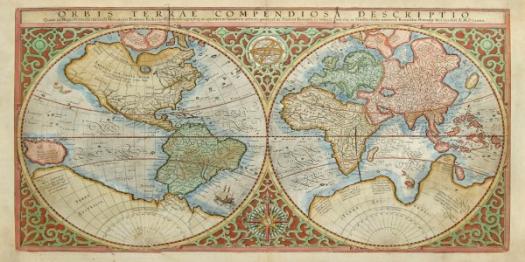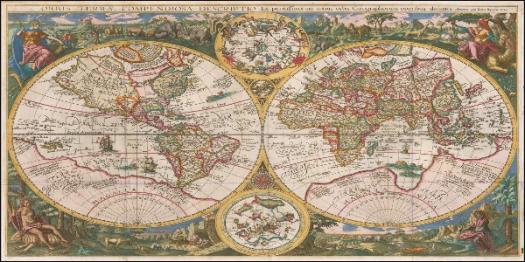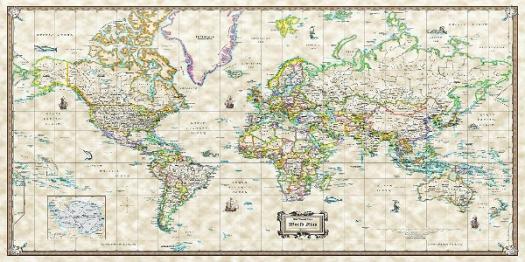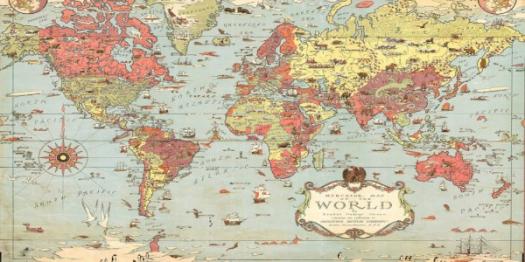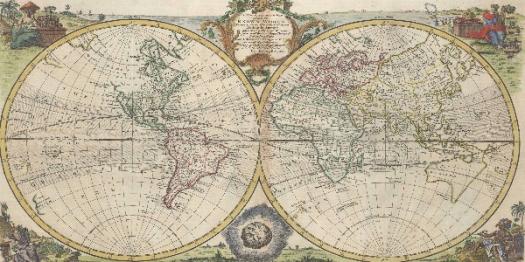Do You Have Basic Idea About Cartography? Trivia Quiz

Cartography can be simply defined as the science of making clear, standard and detailed maps. This science is based on the fact that real life elements can be represented using symbols and shapes on a piece of paper. Undoubtedly, cartography is closely related to geography. How much do you know about cartography?
- 1.
Which of these is not element in a standard map?
- A.
Lettering
- B.
Color
- C.
Texture
- D.
Space
Correct Answer
C. TextureExplanation
In a standard map, elements typically refer to visual representations such as symbols, lines, and shapes that represent different features on the map. Lettering, color, and space are commonly used elements in a standard map to convey information. However, texture is not typically considered an element in a standard map as it does not play a significant role in representing geographic features or conveying information.Rate this question:
-
- 2.
When was the Beaver map published?
- A.
1723
- B.
1781
- C.
1715
- D.
1791
Correct Answer
C. 1715Explanation
The correct answer is 1715. This means that the Beaver map was published in the year 1715.Rate this question:
-
- 3.
Who published the Beaver map?
- A.
Paul Beaver
- B.
Thomas Dufresne
- C.
Patrick Johnson
- D.
Herman Moll
Correct Answer
D. Herman MollExplanation
Herman Moll is the correct answer because he is the one who published the Beaver map.Rate this question:
-
- 4.
Which of these is not used in mapmaking?
- A.
Vernier
- B.
Printing press
- C.
Ink
- D.
Quadrant
Correct Answer
C. InkExplanation
Ink is not used in mapmaking because maps are typically created using digital software or by drawing with specialized tools such as pens or pencils. Ink is not commonly used because it can be difficult to make corrections or changes once it has been applied to the map. Additionally, ink may fade or smudge over time, making the map less reliable or legible.Rate this question:
-
- 5.
Which of these is not an optical instrument used by mapmakers?
- A.
Telescope
- B.
Google
- C.
Theodolite
- D.
Sextant
Correct Answer
B. GoogleExplanation
Google is not an optical instrument used by mapmakers. Google is a search engine and technology company that provides online services and software. It does not fall under the category of optical instruments used for mapmaking, which typically include instruments like telescopes, theodolites, and sextants that are used for measuring angles, distances, and locations on maps.Rate this question:
-
- 6.
Which of these is not related to cartography?
- A.
Remote sensing
- B.
Satellite imagery
- C.
Aviation
- D.
Aerial photography
Correct Answer
C. AviationExplanation
Aviation is not related to cartography because it refers to the operation and use of aircraft, while cartography is the study and practice of creating maps. While aviation may rely on maps for navigation purposes, it is not directly involved in the creation or study of maps like remote sensing, satellite imagery, and aerial photography are.Rate this question:
-
- 7.
Which of these is not a cartography technology?
- A.
GIS
- B.
Laser rangefinders
- C.
Field-rugged computers
- D.
Inverters
Correct Answer
D. InvertersExplanation
Inverters are not a cartography technology. Cartography technologies typically involve the use of tools and software for creating, analyzing, and interpreting maps and geographic data. GIS (Geographic Information System) is a cartography technology that allows for the capture, storage, manipulation, analysis, and presentation of spatial data. Laser rangefinders are used in cartography for measuring distances and elevations accurately. Field-rugged computers are used for data collection and analysis in the field. Inverters, on the other hand, are devices used to convert direct current (DC) to alternating current (AC) and are not directly related to cartography.Rate this question:
-
- 8.
Which of these refers to special purpose maps?
- A.
Thematic cartography
- B.
Orienteering
- C.
Relief cartography
- D.
General cartography
Correct Answer
B. OrienteeringExplanation
Orienteering refers to special purpose maps because it is a specific type of navigation that involves using a map and compass to navigate through unfamiliar terrain. Orienteering maps are designed with specific features and symbols that are necessary for this activity, such as contour lines, vegetation types, and man-made features. These maps are not used for general navigation or for representing a wide range of geographic information like other types of maps, making them special purpose maps.Rate this question:
-
- 9.
Which of these is a form of cartographic symbology?
- A.
Map coloring
- B.
Map projection
- C.
Map lettering
- D.
Map texting
Correct Answer
A. Map coloringExplanation
Map coloring is a form of cartographic symbology because it involves using different colors or patterns to represent different features or attributes on a map. This technique is commonly used to visually differentiate between different land uses, political boundaries, or other geographic features. By using distinct colors or patterns, map coloring helps to convey information and make the map easier to interpret for the viewer.Rate this question:
-
- 10.
Which of these refers to a makes pictorial language?
- A.
Compass rose
- B.
Key
- C.
Bar scale
- D.
Relief
Correct Answer
B. KeyExplanation
A key refers to a makes pictorial language as it is a symbol or code used to represent different features or elements on a map or diagram. It helps in understanding the meaning of various symbols or colors used in the pictorial representation, making it easier to interpret the information conveyed by the map or diagram.Rate this question:
-
Quiz Review Timeline +
Our quizzes are rigorously reviewed, monitored and continuously updated by our expert board to maintain accuracy, relevance, and timeliness.
-
Current Version
-
Mar 21, 2023Quiz Edited by
ProProfs Editorial Team -
Jun 06, 2019Quiz Created by
Gregorynaomi
- Continent Quizzes
- Earth Science Quizzes
- Easy Geography Quizzes
- Environment Quizzes
- Fictional Geography Adults Quizzes
- Five Themes Of Geography Quizzes
- Human Geography Quizzes
- Imperialism Quizzes
- Island Quizzes
- Land Quizzes
- Latitude And Longitude Quizzes
- Nation Quizzes
- Nature Quizzes
- Ocean Quizzes
- Physical Geography Quizzes
- Planet Quizzes
- Regional Geography Quizzes
- Remote Sensing Quizzes
- World Geography Quizzes
 Back to top
Back to top



